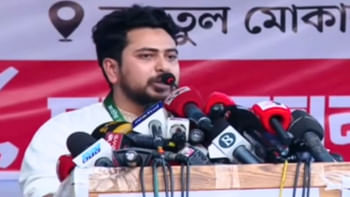The mosquito handler of Lalbagh


As the two city corporations grapple with the dengue outbreak in the capital, the need to use effective insecticides has made the headlines over the last few weeks. However, finding the right mosquitocide requires testing, and field-testing requires standardised samples of mosquitoes.
As it turns out, collecting hundreds of alive mosquitoes grouped evenly in 10 separate containers to be tested for insecticide efficacy is not a task a lot of people would be up for.
In fact, as far as the city corporation authorities and researchers are aware, there is only one man doing it.
On a visit to the Nagar Bhaban of Dhaka South City Corporation (DSCC) on Tuesday, this correspondent came across that man, Sheikh Chunnu -- walking in with a mosquito net fitted on a metal frame, buzzing with the pesky pests.
DSCC officials had entrusted Chunnu with the job, for field-testing its insecticide samples to see which one is most effective, as they have done over the last 20 years.

A fogging machine mechanic for Mosquito Control Department, the 55-year-old Chunnu is somewhat of a self-taught mosquito breeder and handler.
Not just officials of the city corporations, but researchers and entomologists also often call upon his rather unique service.
This correspondent couldn’t help but sit down with Chunnu for a cup of tea at a roadside stall to hear his story.
“I am the sole person providing mosquitoes to the city corporations,” said Chunnu -- in an inimitable Dhakaiya accent and with just a hint of humblebragging.
THE ART AND SCIENCE OF MOSQUITO-BREEDING AND HANDLING
“You won’t want to go to the place where I collect mosquitoes from. I collect larvae from garbage-filled canals or waterlogged pits in Kamrangirchar. You have to be very careful while collecting larvae, because if they sense your presence, they dive into the water,” said Chunnu, a long-time resident of Lalbagh.
The larvae are collected in a bucket, and put in different pots. The pots are placed under mosquito-net cages at his office. After a couple of days, the larvae grow into mosquitoes.
A piece of cotton soaked with glucose is put on the net, where the mosquitoes feed from.
But that is just the first part of his job.
He then needs to put the mosquitoes in other cages, counting them as per requirement of testers.
“This is the part where it gets hard. Through a transparent plastic pipe, I have to suction the mosquitoes using my mouth, and put them into other mosquito nets by blowing into the pipe. Inside the pipe is a net to prevent the mosquitoes from entering his mouth.
City corporation employees were running field tests on some 10 to 12 cages to test the newly-arrived insecticide samples. Exactly 50 mosquitoes are required to be put in each cage.
This correspondent saw Chunnu doing the painstaking procedure without a break for more than two hours.
“When the suction pipe’s width is bigger, it becomes difficult to suck mosquitoes in the pipe, and now it’s causing me breathing problems,” said Chunnu.
PRIDE OVER MONEY
Although he gets no additional payment for this incredibly specific skill-set, Chunnu takes pride in his work, as sometimes experts come to him for assistance.
“I get a call once a month on average to supply mosquitoes; sometimes from city corporation, sometimes from IEDCR (Institute of Epidemiology, Disease Control and Research) and sometimes from Krishibid Institution,” said Chunnu.
Liakat Hossain, store and purchase officer of DSCC, had high praise for Chunnu.
“Whenever we need mosquitoes, we can always turn to Chunnu Mia. He has been doing it for years for us,” he said.
Chunnu has two sons, and a daughter who recently got married. Chunnu sometimes takes his son-in-law to help him with his work.
A PARTING TRICK
Near the end of the conversation, this correspondent asked whether he could distinguish male mosquitoes from female.
“I learned that a long time ago from a doctor. Come, let me show you,” said an enthused Chunnu, drawing attention to a mosquito cage.
He then proceeded to show a simple feature to distinguish between the two -- one that can be done with the naked eye.
Male mosquitoes have furry antennas while female mosquitoes do not have hair on theirs.
Do you have a Dhaka Vibe story to share? Share your reports or ideas to [email protected]

 For all latest news, follow The Daily Star's Google News channel.
For all latest news, follow The Daily Star's Google News channel. 



Comments